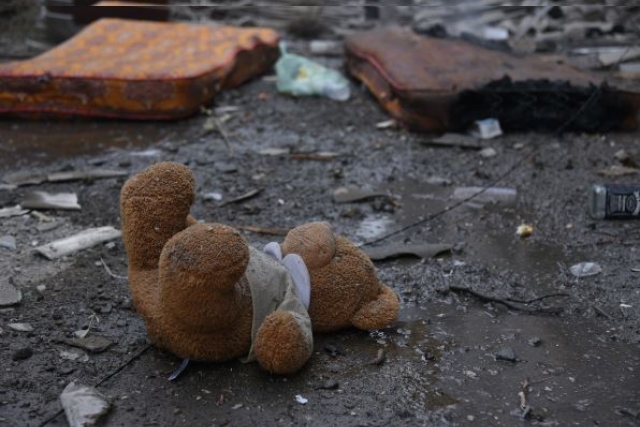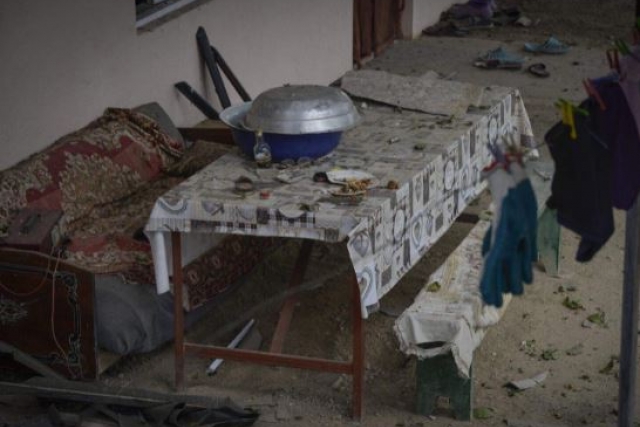Propaganda War Between Azerbaijan, Armenia

Scene at Stepanakert after alleged shelling by Azerbaijan (image via Armenia MFA Spokesperson)
With Azerbaijan and Armenia accusing each other of destroying equipment and killing troops as well as civilians only for it to be denied later, both sides appear to have crafted well-thought out propaganda strategies.
A week ago, clashes first erupted between the former-Soviet nations over the volatile Nagorno-Karabakh region. Nagorno-Karabakh lies within Azerbaijan but has been under the control of ethnic Armenian forces backed by the Armenian government since 1994.
Within a day of conflict, the Azeri side said they destroyed two BM SAM "OSA-AKM,” one MLRS "Uragan,” one BMP, 4 MLRS "Grad,” 4 howitzers D- 20, 16 tanks and 2 trucks. Military observers consider them to be false. As quoted by topwar.ru, they said that a mock anti-aircraft missile launch platform was destroyed instead of the OSA air defense system.
Armenia alleged one of its Su-25 jets was shot down by an F-16 operated by Azeri-ally Turkey on September 29, a claim that was rejected by both Azerbaijan and Turkey. The Armenian Unified Infocenter, managed by the Armenian government, said that the F-16 took off from Ganja Airbase in Azerbaijan at 10:30 am local time.

Fahrettin Altun, communications director for Turkey’s president remarked that the allegation was “absolutely untrue.” Azerbaijani officials called it “another fantasy of the Armenian military propaganda machine.”
Earlier that day, Azeri Ministry of Defense said Armenian forces shelled the Dashkesan region in Azerbaijan, which was instantly dismissed by Armenia whose Foreign Ministry said the reports were laying the groundwork for Azerbaijan “expanding the geography of hostilities, including the aggression against the Republic of Armenia.”
France has accused Turkey of sending Syrian mercenaries to take part in the fight against Armenian forces. “We now have information which indicates that Syrian fighters from jihadist groups have (transited) through Gaziantep (southeastern Turkey) to reach the Nagorno-Karabakh theatre of operations. It is a very serious new fact, which changes the situation,” French President Emmanuel Macron told reporters last week.
Even Armenia’s ambassador to Russia claimed that Turkey sent about 4,000 fighters from Syria. Later, an official Azerbaijani spokesperson refuted these allegations, telling TASS it was "false information and fake."
Canada joined the club today. François-Philippe Champagne, the Canadian Minister of Foreign Affairs said in a statement: “Over the last several days, certain allegations have been made regarding Canadian technology being used in the military conflict in Nagorno-Karabakh…. In line with Canada’s robust export control regime and the ongoing investigation, I have suspended the relevant export permits to Turkey. Canada calls for measures to be taken immediately to stop violence and protect civilians.”

Azerbaijan “falsely” accused Armenia of launching Tochka missile attack at Mingechevir Hydro Power Plan yesterday. Mingechevir has a population of more than 100,000 and is located 100km (62 miles) from Armenia’s border. The Azeri Army then reportedly fired five LORA (LOng Range Attack) ballistic missiles targeting Stepanakert city in Nagorno-Karabakh citing Armenian alleged attack to “justify” its own attack. Israel had sold LORA missiles with an operational range of 400km to Baku in 2018.
Some military experts say it wasn’t the LORA but a 280mm rocket drilled into the ground by Azeri forces. Justifying their claim, they cited an image produced by the Azeri government that shows no debris at the site of missile impact, only some wood to “keep it in place.” Additionally, the distance between Mingechevir and Armenia is 108km, which is more than maximum range of rockets fired by Armenia’s BM-Smerch multiple rocket launchers.
Armenia yesterday called out Azerbaijan for “spreading fake news.”

“The aggression of Azerbaijan against Artsakh with the support of Turkey and the involvement of the foreign terrorist fighters has been accompanied by the campaign of fake news and disinformation which goes beyond the limits of common sense,” the ministry said.
Mocking Azerbaijan, Armenia added “Having failed to achieve any success in the battlefield, the Azerbaijani side on one hand speaks about its imaginary gains, and on the other hand spreads fake news on the shelling of the Azerbaijani settlements by Armenia.”
Citing the Mingechevir attack, it added: “The recent disinformation about the alleged strikes from the territory of Armenia to the Azerbaijani settlements is case in point."
Armenia’s government-run information centre released footage purportedly showing artillery attacks by Azeri forces on October 4 in the city of Stepanakert. The video shows severely damaged buildings, including an apartment block, and a street covered in debris. According to reports, four civilians were killed and 10 were left wounded in these attacks.
“The aim of this disinformation campaign is to cover up the massive shelling of the large settlements of Nagorno-Karabakh by Azerbaijan since the first day of the war, which resulted in many losses among the civil population, while serious damage was inflicted upon the essential civilian infrastructure,” the Armenian side alleged.
“With the spread of such fake news Azerbaijan also prepares grounds for the continuation of its criminal policy and for the extension of the geography of the war. Each provocation by the Azerbaijani side will receive an adequate response from the Republic of Armenia,” the Foreign Ministry added.









